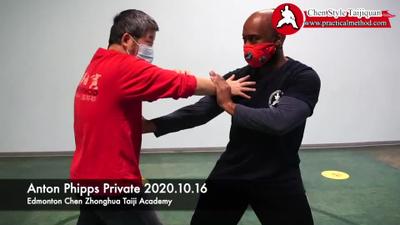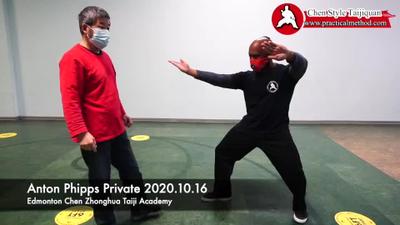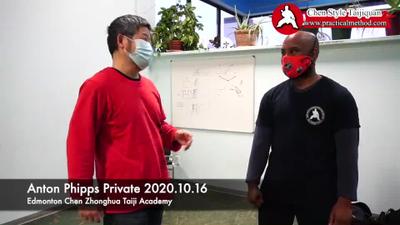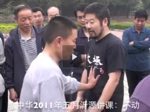Please note: The video was recorded without external microphone. The sound was from normal camera sound capture. It is audible. This is Master Chen Zhonghua’s correction for Anton Phipps for section four of the Chen Style Taijiquan Practical Method Yilu.
At the end of the correction, Master taught a method/concept of how to create a line with elbow/shoulder, and knee/kua. This is a fundamental aspect of the way Chen Style Taijiquan Practical Method uses the body.
Presenter: Chen Zhonghua Length: 50 min. In: English Year: 2020 Difficulty:2/5 At:Edmonton Chen Zhonghua Taiji Academy 埃德蒙顿陈中华太极馆






{ 3 comments… read them below or add one }
Review; D. Gauld
– GM worked with Anton to show him how to connect upper body with the kua, opposite is known as floating
– GM reviewed how this connection is relatively simple to create but infinitely difficult to create at will; simple but not accessible to humans
– when body is solid its due to the overall structure
– when performing PM movements must imagine and create body that goes literally underneath the move
– must learn to squeeze parts of PM structure to create expansion (Peng)
– on ‘high pad (pat?) on horse’ must tear at the split between the two halves of body core rod, learn to ‘touch ear then stroke beard’
– learn how to put them together to create 2-dimensional movement
– must create 3 edges to break up an opponent’s bear hug, at least on arms and back
– punch must be followed by the body
Review:
– Anton given direction to begin to find ways to add “stiffness” to the performance of Yilu and experiment with how to lock the frame without muscular involvement
– in doing ‘silk reeling’ exercises must learn to twist internal connective tissue structures as if they were silk on the outside of a rod (silk the tissues, rod the bones)
– learn how to move bones within by finding ways to twist nonmuscle connective tissue (may include muscle as well?), ligaments/tendons/fascia must all be taught to ‘slide inside’ our skins
– we have to ‘re-tool’ our weapons, our bodies
– nothing comes out or escapes the rotations or reelings, no leaking of energy, lock the non-moving body parts without overt muscular tension, must develop this ability
– we must take responsibility to practice on our own, do rotation drills as individual moves doing thousands of repetitions, with each rep strive to become a bit more skillful, powerful, explosive, etc. with one goal/focus at a time
– this is the process of successive approximation, can be called ‘grinding’ lots of reps to develop neurological and physiological pathways, also grinds out the adhesions/restrictions within joints over time
– work on 3 harmonies; shoulder/kua, elbow/knee, hand/foot
– work to maintain kua closest to opponent as flat to front as possible, stretch beyond what is normally possible regularly, find the middle between too little stretch and a stretch that creates pain indicating damaged tissue
– must learn to ‘disappear’ the butt/glutes in half horse stance
– learn to make knee go up simultaneously with shoulder going down, open joints, keep kua forward or at least flush, convex not concave
– learn to create internal dynamics within each and every movement of Yilu, or all PM moves
– no punches, only hammer blows
– in silk reeling must create the rod/line of body around which the silk will be reeled, without this nonmoving central line there is no reeling of the connective tissues
– must have a straight line in a fight, the tissues contract as in silk twisting then explode along the rod, must study and develop internal springs that can be contracted and expanded with explosive force to be effective in fighting with PM
– learn to contain rotations, isolate and lock
– learn the ‘squeeze’
– must develop a very systematic method of working on our PM skills, like doing an Ikea table kit, study the directions, follow the directions exactly, check out each of the components and learn about each, check on all components, try to put things together at each stage of construction in our minds eye, then attempt to begin to put components together slowly and carefully only using the exact directions given by our teachers and GM
…learning to live, a breath at a time…
Nothing moves, it Tears which is a Spiral
In this video, Master Chen corrects section 4 of Yilu. Particularly of interest was the idea of strength vs Stiffness.
Right from the moves Forward Trick and Rear Trick, I had too much movement. Master Chen said:
“Right now [you] are a strong man, that is why [your] moves are like that. But, that is not the stiffness we require.”
Master Chen then demonstrated what happens when you can lock your body into a frame. This caused a spiral through the body, whereas when he demonstrated what I did, there was movement and thus no spiral. He went on to say:
“Only allow a spiral, when we say spiral, it means it’s tight.”
Master Chen demonstrated building a frame out of the centre of the chest, the shoulder, and the wrist. When the points were locked there was indeed no movement. When the lock was lost, there was visible tossing. Master Chen said:
“If you have any movement, you might as well lose the whole thing. It is like a train, it has to be on the rail, it can’t sway a little bit. That is the explanation, but we say ‘be a little bit stiffer.’ […] You only allow a tearing, which is a spiral.”
Master Chen then had me continue going through the form with extra attention paid to the rod in the body, and maintaining proper structure (not collapsing). Also in this video Master Chen speaks about how to perform the techniques without moving the inside despite the extreme contortion of the body, and what exercise can be done to gain this ability.
At the end there is a section on the three harmonies, and the correct body posture which is essential.